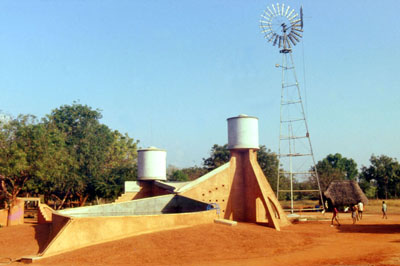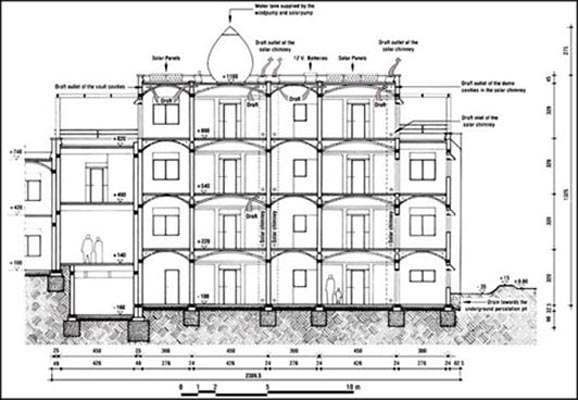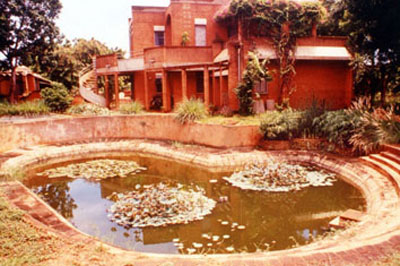Vikas Community
- Sharanam Center for Rural Development, 2015-2018
- Kaza Eco-Community Centre, 2013-2015
- Realization Community, 2007-2012
- Movable House, 2008
- Nataraja Temple, 2006
- Marakkanam, 2005-2006
- Al Medy Mosque, 2004
- Aum House, 1999
- Dhyanalinga, 1998-1999
- Vikas Community, 1991-1998
- Deepanam School, 1994-1995
- Visitors Center, 1989-1992

VIKAS SPIRIT
The creation of this community was based on a particular spirit, life style and appropriate architectural design. It was related to Sri Aurobindo’s integral yoga and Auroville’s ideal. The extensive use of environmentally sound materials, appropriate building technologies, (earth and ferrocement), renewable energies (solar and wind) and ecological water management (watershed harvesting and biological waste water treatment), were the basis of its material implementation. Individual apartments, a few individual houses and common facilities were built.

This project was the first development in Auroville, which used stabilised earth right from foundations to roof. To date, Vikas community still represents the most synthetic holistic development, which has been materialised in Auroville.
The community was built in several steps, from 1992 to 1998. First the community kitchen was built, so as to emphasize the communal aim. Then a first block of 4 apartments was built and later on a second block with 5 apartments. The third block with 13 apartments was built on four floors: a basement floor with three floors above it. The concept of this building was such that it should be self-sufficient for its soil needs. The soil was dug from the basement floor (1.20m below the original ground level) to produce compressed stabilised earth blocks for building the structure of 819m2, carpet area, on 4 floors.
The foundations were done with stabilised rammed earth and the 13.40m high walls were done with CSEB of 24 cm thick. All floors and roofs were made of very flat vaults and domes for the living rooms. These vaults and domes were built with CSEB, by using the “Free-spanning” technique. All stabilisation used 5 % cement by weight.
The experiment of Vikas found its roots in Auroville’s ideals. Nonetheless, its material developments could be implemented elsewhere in the world. Vikas community was a finalist for the World Habitat Award 2000.
FIRST DEVELOPMENT



UNIQUE FEATURES OF THE THIRD BUILDING
Earth was used, from the first developments of Vikas, in all parts of the buildings, from foundations to roof. The proper management of earth resources was always the first priority. The quarries where the soil was taken from were always planned first. This procedure allowed a perfect integration of the excavations with the buildings and landscape. The first and second developments of the collective kitchen and 10 apartments on two floors could integrate the quarries as a garden reservoir and for wastewater treatment.
The soil needs for these developments were already exceeding the outcome of excavations, and some soil had to be supplied from elsewhere. The soil requirement for the third building, which had four floors, was tremendous and the development of Vikas did not require any hole. Thus it was not possible to integrate any earth excavation in the project and therefore this building was planned with a basement floor, which was half underground (1.20m below the original ground level).

The volume of this basement floor was equivalent to the volume of soil, which was needed to produce the blocks and all the various works of the third building. Thus, the amount of soil generated by the basement was enough to build 819 m2, carpet area, on 4 floors.
To protect the basement from the inflow of rainwater a particular landscape was designed. The immediate surrounding has been shaped like a shallow crater to drain rainwater into a percolation pit. This landscape design generated even more soil than needed for the building sites at Vikas. It was given to other projects in Auroville, which could not implement the concept of a basement floor.














MAIN SPECIFICATIONS OF THE THIRD BUILDING
| WORK | TECHNIQUE |
| FOUNDATIONS | • Stabilised rammed earth |
| BASEMENT | • AURAM plain blocks 240 |
| PLINTH BEAM | • RCC plinth beam cast in a block shuttering with AURAM blocks 240 – ½ size |
| BASEMENT WATERPROOFING | • Walls: with bitumen paint on a stabilised earth plaster • Floor: with a layer of pebbles |
| BASEMENT DRAIN | • Underground drainage, (ø3” slotted PVC pipe) sent to an underground percolation pit • Surface drainage with a percolation pit |
| GALLERIES’ FLOORING | • AURAM tiles 240 |
| APARTMENTS FLOORING | • The choice was left to people: CSEB, terracotta or ceramic tiles |
| WALLS | • AURAM plain blocks 240 |
| RING BEAMS | • Composite ring beam with AURAM U blocks 240 and RCC |
| SPRINGER BEAMS | • RCC beams for resting vaults and domes |
| LINTELS | • Composite lintel, single height, with AURAM U blocks 240 and RCC |
| COLUMNS | • Composite pillar with AURAM round hollow blocks 240 and RCC |
| FLOORS AND ROOFS | • Flat vaults and domes with AURAM blocks 240, laid without support • Precast ferrocement channels |
| PLASTERS | • Stabilised earth plasters for some walls |
• Energy intelligent building
• Natural ventilation and sun protection
• Integration to the land, according to the existing nature, trees, etc.
• Adaptation to the climate, according to main winds directions, sun, etc.
• Stabilised rammed earth foundations with 5 % cement
• Plinths and walls in compressed stabilised earth blocks
• Stabilised rammed earth walls with 5% cement
• Composite beams and lintels and composite columns
• Vaults and domes for floors and roof, made of CSEB
• Paints and plasters with stabilised earth
• Floorings with CSEB tiles, 2.5cm thick with 5 % cement
• Ferrocement channels of 25mm thickness
• Various ferrocement items for different uses
• Ferrocement doors, shelves, etc. of 12mm thickness
• Ferrocement plasters for water tanks and ponds
• Sparing use of concrete, glass, steel, etc.
• Compressed stabilised earth blocks of various qualities
• Various stabilised earth based materials
• Ferrocement pieces in various parts of the buildings
• Photovoltaic panels for the electricity (12 V DC)
• Surface solar pumps for the gardens
• Submersible solar pump and wind pump
• Rain water harvesting to aim zero run off during the monsoon
• Biological wastewater treatments
• Soil for building was extracted from the site itself
• Percolation systems to harvest rainwater
• Wastewater treatment pond
• Reservoirs for garden water
• Basement floor
LAND CONSERVATION AND RAINWATER HARVESTING
 Typical bund on eroded land
Typical bund on eroded land
 Development in Vikas Development in Vikas |
This type of land conservation became very effective, but it was adapted to green works and not for developing a city. Therefore, the development of Vikas tried to integrate these principles into town planning. The typical bunds to retain rainwater were transformed into smooth landscape. Gentles slopes with shallow depressions collected rainwater and top edges, where the pedestrian paths were located, retained water. The lowest part was sometimes flooded and allowed the percolation. The top part was always accessible without paddling. They were as effective as the original developments but totally integrated in the landscape. |
Landscaped percolation pits
The percolation effectiveness is increased tremendously with vegetation. It is essential to cover the percolation system with grass and to plant bushes. Their roots drain rainwater much faster in the ground. The biological systems with microorganisms, which are present in humus, aerate the ground and increase also tremendously the percolation. This was shown by the first percolation system created for the park near the collective kitchen. The percolation system had just been shaped when a heavy summer storm occurred. No grass cover and landscaping had been done yet. The depression was flooded and rainwater took nearly a week to percolate through the topsoil, which had no humus. Once vegetation completed the system, the heaviest rainfall during monsoon would take one or two days to percolate.



BIOLOGICAL WASTE WATER TREATMENT BY LAGOONING
This system consists of two distinct phases: an anaerobic decantation-digestion, followed by a macrophyte water treatment and the progressive re-establishment of aerobic conditions. The anaerobic treatment takes place in a watertight pit called the “decanter-digester”, which is open at the top, and which gets covered by the accumulated floating matter.


The macrophyte water treatment is covered with diverse species of floating aquatic plants. The first 2/3 of the watertight pit is fully covered and the plant covering in the last third is restricted to 20 % of the surface to promote more re-oxygenation and photosynthesis. The aquatic plants were at the beginning water hyacinths and duckweeds. This wastewater treatment worked well but it is a fragile system, which requires a lot of maintenance.
Further toxic products, such as bleach, house hold products with caustic soda, etc. should not be used and it happened twice that people thrown such thing in the toilets. Therefore, the biological system died for sometimes: it started to smell, fishes died and the area was infested by mosquitoes. Once normal wastewater goes into the system, the latter require a few weeks to function again properly.
The lagooning system was finally changed for another system which more resistant and needs less maintenance: a baffle reactor system.
Along with an ecological approach for this biological wastewater treatment, the idea was to fulfil technical requirements with a sense of integration, harmonization with the buildings & surrounding nature.
Therefore, buildings nearby invited the lagooning system. It tried to propose an agreeable place, where people can walk, sit and stay for a while, so as to enjoy a pleasant pond, which is treated as a lake.
LEGAUM HOUSES
The initial concept was to build moveable houses. The need arose due to the housing shortage in Auroville. The international city of Auroville is under construction and, at this time, there was no master plan. Therefore, allowing building anything anywhere could have hinder major developments, which should happen later on. The concept of a moveable house was born, which can be built in a short time. It could stay in place until the time major development occurs. It could then be dismantled, without loss of materials, and rebuilt elsewhere. A first prototype was built in 1996 and it presented totally new technical features. Its main disadvantage was an outrageous cost. A second prototype evolved into a lighter version and was built in 1997. Its cost came down to one third the price of the first prototype and thus was cost effective.
Therefore the aims of the concept were fulfilled. But social acceptability remained one main problem. For most people a house is a life’s investment and a dream, even in Auroville. It must fulfil the need of being rooted to a place and the sense of property, which is given by a house rooted in the ground. Therefore these moveable houses, as they had no foundation, were “un-rooted” and did not fulfil this psychological need.
More “rooted” houses were built by self-builders, who were really happy to build them and who are feeling at ease inside. These people got a three-week training course and we gave them the basic plans of the houses. They were left alone to manage everything and they finally developed the original concept, with additional alcoves, and six houses were built in a year time.






VARIOUS ACTIVITIES
The initial concept was to build moveable houses. The need arose due to the housing shortage in Auroville. The international city of Auroville is under construction and, at this time, there was no master plan. Therefore, allowing building anything anywhere could have hinder major developments, which should happen later on. The concept of a moveable house was born, which can be built in a short time. It could stay in place until the time major development occurs. It could then be dismantled, without loss of materials, and rebuilt elsewhere. A first prototype was built in 1996 and it presented totally new technical features. Its main disadvantage was an outrageous cost. A second prototype evolved into a lighter version and was built in 1997. Its cost came down to one third the price of the first prototype and thus was cost effective.
Therefore the aims of the concept were fulfilled. But social acceptability remained one main problem. For most people a house is a life’s investment and a dream, even in Auroville. It must fulfil the need of being rooted to a place and the sense of property, which is given by a house rooted in the ground. Therefore these moveable houses, as they had no foundation, were “un-rooted” and did not fulfil this psychological need.
More “rooted” houses were built by self-builders, who were really happy to build them and who are feeling at ease inside. These people got a three-week training course and we gave them the basic plans of the houses. They were left alone to manage everything and they finally developed the original concept, with additional alcoves, and six houses were built in a year time.







The attempt to sustainable development is to integrate an alternative building process, various appropriate building technologies and renewable energy sources, so as to promote eco-friendly and sustainable development.
In this field earth, as a raw building material, plays a major role, but other appropriate technologies such as ferrocement, biological wastewater treatment, solar lighting, wind and solar pumping are also extensively used.
Multi aspects of Sustainability



Appropriate building materials and technologies


Vikas community near the centre of Auroville has been our main achievement. The implementation of the project was based on appropriate architectural design, on which people collaborated with the architect of the Auroville Earth Institute, formerly named AVBC/Earth Unit.

Renewable Energies
About Sustainable Development
“Sustainable development is development which meets the needs of the present without compromising the ability of future generations to meet their own needs.”
World Commission on Environment and Development
A few key words
• Respect of Nature but also people
• Needs of people, from most basics ones to economic, social and spiritual growth
• Interdependency, between people and between Nature and people
• Limits of the environment, as the earth resources are limited
It requires first a proper management of resources, but also: waste reduction, proper wastewater treatment, low emissions, use of renewable energy and eco-friendly materials, etc.
It integrates all group categories and levels (ethnic, religious, economic, health, etc.). Quality of life, uplifting local skills, impacts on local communities, etc, should also be taken into account.
It promotes endogenous growth, which is linked with the creation of new market opportunities, cost reduction through efficiency improvements, creation of additional added value, etc.
That building with earth can be synonymous with sustainable development and a harmonious integration of buildings in the physical and social environment.
Kenyan Proverb
A habitat is much wider than simply the built environment, whether a house, a hospital, a school, or any urban facility. It includes the totality of the environment – not only the physical surrounding but also the social one, our neighbourhood. It takes into account a proper management of resources and development such as drainage and wastewater management systems, water and energy supply, transportation, appropriate building technologies, renewable energy sources such as sun and wind energy, use of locally available materials and skills, etc.
Sustainable habitat requires a holistic approach. This needs to integrate first the human aspect, which implies a different process, where people’s participation is essential for its success. Secondly, only a sustainable habitat needs to integrate various technical parameters, such as:
• Appropriate urban planning – the population in its environment and technical means
• Appropriate architecture design – adapted to the environment (physical, social and technical)
• Renewable energy sources and appropriate building materials
• Management of resources and use of environmentally sound building materials
• Water management – drinking water supply, rainwater harvesting and wastewater treatment
• Earth management when people are using earth extensively as a building material
One should not forget that materials and techniques are just tools to achieve sustainable habitats. It goes further than just structures and urban development, as it deals with social relations and patterns. Habitat and especially sustainable habitat cannot be understood just as a finished product. It is a constantly evolving system and the process to develop it is always essential.
Therefore, the matter is not only to create eco-friendly facilities for everyone’s wealth but also to imagine different relations among people – to create a synergy going towards respect on all levels and towards a different lifestyle based on harmony, friendship, disinterestedness and compassion rather than the usual egoistic behaviours of indifference, competition or strife.
Contact US
- Address:Auroville Earth Institute, Auroshilpam, Auroville 605 101 - T.N. India
- Phone:+91 (0) 413 - 262 3330 / 262 3064
- Email:info@earth-auroville.comOpens in your application

